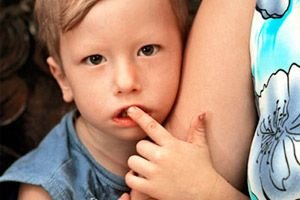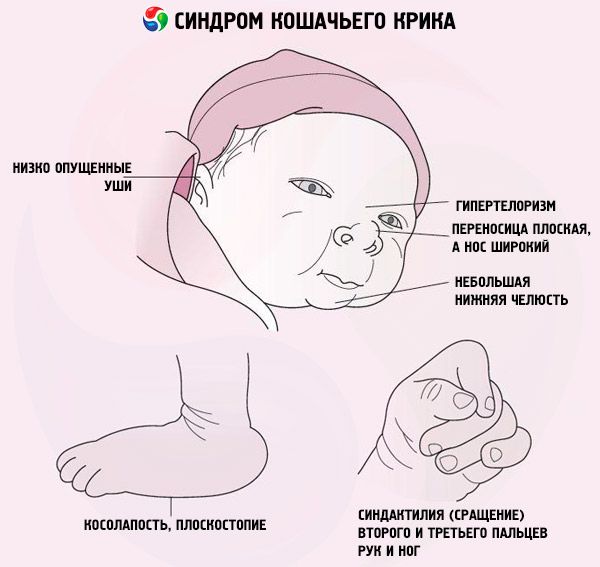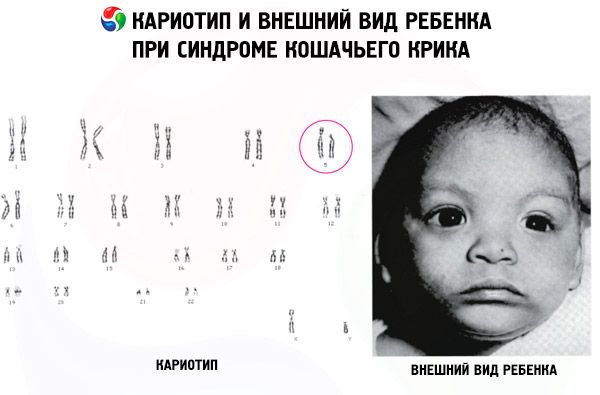
All iLive content is medically reviewed or fact checked to ensure as much factual accuracy as possible.
We have strict sourcing guidelines and only link to reputable media sites, academic research institutions and, whenever possible, medically peer reviewed studies. Note that the numbers in parentheses ([1], [2], etc.) are clickable links to these studies.
If you feel that any of our content is inaccurate, out-of-date, or otherwise questionable, please select it and press Ctrl + Enter.
Catcall syndrome
Medical expert of the article
Last reviewed: 04.07.2025

Cri du chat syndrome (sometimes also called Lejeune syndrome) is a rare hereditary disease in which a child has a cry that sounds like a cat's meow. The syndrome is considered a chromosomal pathology, as it occurs due to the absence of part of the genetic information located in the p-arm of chromosome No. 5. This disease is detected in approximately 1 in 45-50 thousand newborns. The syndrome develops more often in girls - in a ratio of about 4 to 3.
Causes catcall syndrome
The source of the mutation that causes Lejeune syndrome can be a variety of factors that negatively affect the reproductive organs of the parents or the fertilized egg, which is in the process of division with the subsequent formation of a zygote. Among the main causes of mutation are:
- Heredity. If there is a child in the family with this pathology, the probability that the second baby will be born with the same diagnosis is high;
- Alcoholic drinks. They are very harmful to the health of the fetus and the mother's reproductive cells;
- Smoking;
- Drugs. They have a destructive effect on the entire genetic apparatus;
- Exposure to ionizing radiation;
- Medicines or chemical substances with a strong effect that the pregnant woman took in the 1st trimester.
Mutation type in Cri du chat syndrome
Genetically, this syndrome is explained by partial monosomy. Its occurrence is associated with a chromosomal rearrangement, during which from 1/3 to half of the p-arm of chromosome No. 5, which contains about 6% of all genetic material, is lost. The clinical picture of the disease is affected not by the size of the missing part, but by which fragment was lost.
Pathogenesis
Cri du chat syndrome is caused by changes in the p-arm of chromosome 5, which usually develop due to division or, in some cases, translocation.
 [ 4 ]
[ 4 ]
Symptoms catcall syndrome
Among the main symptoms of Cri Du Chat syndrome:
- A specific sound of the patient's cry, similar to a cat's meow. This symptom is associated with the fact that the sick child's larynx has some features - with thin cartilages, underdeveloped and quite narrow. In about a third of all children, this feature disappears before the age of 2, and in the rest it persists throughout life;

- A full-term baby has a low birth weight (less than 2.5 kg);
- Problems with swallowing and sucking function;
- There is copious secretion of saliva;
- The face has a moon-shaped, rounded shape (this feature may disappear with age);
- Wide-set, slanted eyes, their outer corners droop downwards, and near the inner corners there is an epicanthus (small fold);
- The bridge of the nose is flat and the nose is wide;
- Low-set ears;
- The skull and brain are small, and there are very prominent frontal protrusions. This symptom becomes more pronounced with age;
- Small lower jaw;
- The neck is short and has folds of skin;
- The child's mental development is delayed, and physical and speech skills also develop with a delay;
- The behavior has some peculiarities - hyperactivity, unmotivated aggression, repetitive movements, hysteria are observed;
- Frequent constipation;
- Decreased muscle tone of the patient's body;
- Heart defects (abnormalities in the structure of the septa (interventricular or interatrial), blue heart defect).
Forms
There are several types of mutations that influence the development of the disease:
- The short arm is completely absent - this is the most common variant of the syndrome (and the most severe). When there is a complete loss of the arm, about ¼ of all the genetic information that is located on chromosome #5 disappears. In addition to the genes themselves, some important parts of the genetic material also disappear, which is why the anomalies that arise in the body become more numerous and more serious.
- Shortening is observed - in this case, only some part of the genetic material that was closer to the final section of the chromosome disappears. If this is accompanied by a rearrangement of chromosomes in the section where the key genes for development are located, Lejeune syndrome develops. With this variant, there will be fewer developmental defects in the child, because a smaller amount of genetic material has disappeared.
- Mosaicism is a mild form of the syndrome, which is observed quite rarely. The child receives defective DNA from one of its parents. With this type of mutation, the zygote's genome was initially correct, chromosome #5 was complete - the disorder occurred during the development of the fetus itself. During the process of chromosome division, the p-arm disappeared, without undergoing division between the daughter cells. Therefore, some of the body's cells receive a defective genome. With this form of the syndrome, pathological changes will be insignificant, because the division of normal cells to some extent compensates for the defectiveness of the rest. Therefore, severe congenital anomalies or any delays in physical development are usually not found in such children, but mental deviations may still be present.

- Ring form - two arms (short and long) of one chromosome are linked together, which makes the chromosome look like a ring. In this case, chromosomes are rearranged in a small terminal section. The syndrome manifests itself with some symptoms if key genes disappear.
 [ 5 ]
[ 5 ]
Complications and consequences
With Lejeune syndrome, the patient dies not from the disease itself, but from complications - kidney or heart failure, various infections.
Diagnostics catcall syndrome
The disease can be preliminarily diagnosed by the baby's appearance and specific cry. To clarify the diagnosis, a cytogenetic analysis is performed, and the chromosome set is also studied. Such an examination can be carried out on parents planning to conceive - in cases where chromosomal diseases have previously been observed in the family.
 [ 6 ]
[ 6 ]
Tests
To diagnose the disease, urine and blood are taken from the newborn for general and biochemical analysis. Characteristic signs of the disease in this case will be such signs as a decrease in albumin levels in the blood, as well as embryonic hemoglobin that persists for a long time.
 [ 7 ]
[ 7 ]
Instrumental diagnostics
Methods of instrumental diagnostics of the disease:
- Echocardiography, as well as electrocardiography - to detect the presence of heart defects;
- An ultrasound or X-ray procedure to detect abnormalities in the development of the digestive system.
What tests are needed?
Differential diagnosis
Cri du chat syndrome must be differentiated from other chromosomal pathologies that have similar symptoms – these are Patau, Down or Edwards syndromes.
Who to contact?
Treatment catcall syndrome
There is no specific treatment for Lejeune syndrome; only symptomatic therapy is performed for the pathologies that arise as a result of this disease.
To stimulate the child's psychomotor development, he/she should be observed by a pediatric neurologist, who will conduct courses of massage, drug treatment, exercise therapy, and physiotherapy. In addition, children with such a diagnosis need the help of speech therapists, defectologists, and psychologists.
If a baby has a heart defect, it often requires correction through surgery, so the patient is referred to a cardiac surgeon who conducts an examination, does an echocardiogram and other necessary procedures.
If a child has a urinary tract pathology, he is referred to a pediatric nephrologist, who prescribes various examinations for the patient - taking urine and blood for analysis, diagnosing the kidneys using ultrasound, etc.
Prevention
Prevention of the disease is thorough preparation for pregnancy, as well as the exclusion of any possible negative factors on the body of future parents before conception. If a child is born with Lejeune syndrome, his parents must undergo a cytogenetic examination to be tested for carriage of a balanced chromosomal rearrangement.
 [ 8 ]
[ 8 ]
Forecast
Cri du chat syndrome has an unfavorable long-term prognosis. The quality of life, as well as its duration with this syndrome, depends on the type of mutation, the severity of concomitant congenital pathologies, and the level of psychological, pedagogical and medical care provided. Children who have undergone a course of special training have a vocabulary that allows them to communicate at the everyday level, but physical and psychological development often remains within the limits of preschool age.

